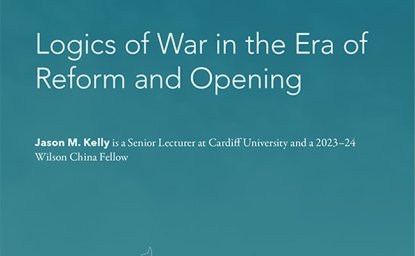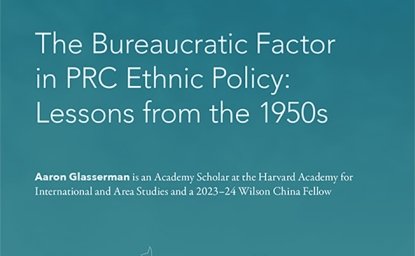278. A Reputation Tarnished: New Perspectives on Interwar Czechoslovakia

T. Mills Kelly is Associate Director of the Center for History and New Media at George Mason University and a multiple Title VIII EES grant recipient. Dr. Kelly spoke at an EES noon discussion on March 26, 2003. The following is a summary of his presentation. Meeting Report 278.
The collapse of the Communist regime in Czechoslovakia had many wonderful consequences. For historians it has meant that so many archives that were once closed to us have been open for more than a decade. As a result, those who write about Czech and Czechoslovak history now have unprecedented access to sources and have had ten-plus years to poke around and to consider what we have found very carefully. At the same time, a new generation of historians interested in Czech, Slovak and Czechoslovak history has appeared, both in Europe and in North America. In North America alone, there are now quite literally dozens of historians who have taken up Czech, Slovak and Czechoslovak history since the mid-1980s and this generation has benefited tremendously from the opening of the archives. The intersection of these two events has meant that much that was once unavailable as a subject of historical study is now at the center of the research programs of many talented historians.
Those of us in the history business know that one of the tasks of any new generation of historians is to cast a cold and sometimes baleful eye on the interpretations of the past bestowed upon us by our mentors in graduate seminars. Each new generation wonders if its predecessors could really be quite that right in their books, articles and public speeches. And, when the new generation suddenly has access to lots of archival material that the previous generation could not use, the possibilities are almost endless. The new generation of Czech, Slovak and Czechoslovak historians has embarked upon many different and interesting paths of research, many influenced by the latest trends in European and American scholarship. Compared to ten years ago, we know much more about the history of Czechoslovak women, about the interconnections between Czechoslovak culture and the wider European cultural sphere, about the importance of public ritual and constructed memory, and many other topics. We also know a great deal more about specifically Czechoslovak topics: the expulsions of the Czechoslovak Germans, anti-Semitism in both the Czech and Slovak halves of the state, and the nature of economic relations within the state, to name a few. Emerging from all of this work—or at least from much of it—is an important subtext, namely, that what we might call the "Whig Interpretation" of Czech and Czechoslovak history, is not quite as perfect or as positive as it once seemed.
The Whig Interpretation can be summarized like this: For many centuries the lands of the Bohemian Crown were one of the great cultural, political and economic centers of Europe. But, after their defeat by the dastardly Habsburgs at White Mountain in 1620, the Czechs endured 300 years of Habsburg oppression in a sort of cultural darkness from which only a few glimmers of light emerged. In the last years of the Habsburg state, the oppressed Czech people waged a struggle first for autonomy and then for independence, culminating in 1918 when TomአMasaryk and his loyal minions Edvard BeneŠ and Milan štefánik founded Czechoslovakia, the shining star of democracy in an interwar Europe riddled with dictatorships. Czechs and Slovaks became Czechoslovaks, to the benefit of both (or neither, depending on who you asked). Describing the creation of Czechoslovakia, Josef Korbel wrote: "Thus—and it could have happened nowhere else in Eastern Europe—on October 28, in the ancient rolling plains of old Bohemia and the rugged mountains of Slovakia, two peoples re-emerged as one nation from centuries of serfdom into the full splendor of independence—without firing a shot." But, following the triple tragedy of Munich (in which Czechoslovak democracy was betrayed by Britain and France and by the Slovaks and Czechoslovak Germans), the war and the Communist coup d'état, the Czech and Slovak people descended again into darkness. During the next 40 years, the ultimately tragic Prague Spring of 1968 relieved this darkness only briefly. In 1989, the oppressed Czech people led by Václav Havel—a Masaryk for the 1990s—and his younger and more numerous loyal minions, conquered Communism through the purity of their moral purpose. Despite the best efforts of Havel and others loyal to the idea of Czechoslovak unity, the Republic foundered in 1992 on the rocks of resurgent and bull-headed Slovak nationalism. Through it all, the Czech love of democracy and freedom was like a shining beacon that even in the darkest years of the Communist era beckoned the nation to its ultimate destiny as a great, if small, member of the European family.
Although I have obviously exaggerated it for dramatic effect, this master narrative was and is a bit too perfect. This most Whiggish view of Czech history persists and continues to be replicated in whole or in part in books and articles. The new generation of scholars, however, has begun to question almost every aspect of this master narrative. Here, I would like to focus on five areas of their work that deal with interwar Czechoslovakia.
When we think of interwar Czechoslovakia, it is certainly true that it was much more democratic than its neighbors in East Central Europe and that the state managed to hang on to its original constitutional structure, more or less, until 1938. However, relative democracy—that is, being more democratic than, say Bulgaria or Hungary—is not the same thing as being the kind of democracy in which we would want to live today (or even then). After the adoption of the new Constitution, Czechoslovakia had a parliamentary government with an ostensibly bi-cameral legislature, a reasonably strong presidency and a Constitutional Court. Unlike most of the rest of Europe, all adult Czechoslovaks had the right to vote and all were equal before the law. The political party system was robust—more than a dozen parties across the political spectrum competed in elections at both the national and communal levels and at no time during the First Republic were any of these parties banned, even when doing so might have been in the interest of the state. Thus, on the surface, the political structure of the state looked like a model for the rest of the region.
However, there were many problems with
this system. The first of these was that two of the pillars of the state structure—the Senate and the Constitutional Court—never really functioned as the Constitution intended. Furthermore, because seats in Parliament belonged to the parties rather than to the candidates, the leadership of the political parties dominated the lower house of Parliament through an iron discipline that brooked no internal opposition. From the very beginning of the state, the leading parties (especially the ruling five—the petka—that controlled every cabinet of the interwar period) found themselves in a contest for authority with the presidency—the Hrad. As Jirí Kunc and Robert Luft have pointed out, the parties, which were largely in existence before 1918 and simply continued their Habsburg existence into the First Republic, saw politics as a zero-sum game, in which each party had its own defined ‘territory' within society—a territory that was to be protected at all costs. Further, the Habsburg experience inculcated the party leaderships with a strong distrust of central authority. Thus, interwar Czech politics at the parliamentary level were characterized by a contest for power between a very small number of men in Prague, rather than being an exercise in democracy in its widest sense. At the beginning of the state even Masaryk himself considered the establishment of an interim dictatorship and, in 1925, seriously entertained taking the vote away from women and active duty soldiers. Finally, and this is a critique of the First Republic that has been around since 1918, the exclusion of the Slovaks and the minorities from first the state creation process and later from the exercise of power within the state, dramatically weakened the state and its institutions.
This reality helps to explain the growing disillusion of broad swaths of Czechoslovak society—Czechs as well as others—in their political system and their declining participation in politics. It also helps to explain one of the more puzzling aspects of the aftermath of Munich, namely, why was it that the citizens of Czechoslovakia, especially the Czechs, gave up their democracy with hardly a whimper? What is currently missing from the increasingly rich picture we have of political life at the micro level is a correspondingly rich investigation of local politics in interwar Czechoslovakia. While we are learning more and more about parliamentary politics, our understanding of communal politics is still very limited.
A second critique that has emerged in recent years has been of the actual functioning of the rule of law in Czechoslovakia. It is important to remember that all of the citizens of the new state emerged from the Habsburg regime with long experience with arbitrary applications of the rule of law. Spying by the central government was common, as was censorship. Given this experience it is perhaps hardly surprising—albeit disappointing—that interwar Czechoslovakia carried on as the Habsburg state had done. Opposition parties, especially the Communists and the more nationalist of the minority parties, were subjected to constant spying and subversion by the secret police. I myself have spent a fair amount of time reading the reports of state security police on various political parties in Moravia and they were almost identical to those one finds in the Staatsarchiv in Vienna. The only substantial difference is that the Habsburg foreign ministry spies wrote their reports in German.
In addition, the state authorities were guilty of using the results of this system of internal surveillance to attack political opponents in ways that seem more suited to some of Czechoslovakia's neighbors in the 1930s. Mark Cornwall has recently provided a compelling example of this behavior by the state authorities—the case of the Sudetendeutsch politician Heinrich Rutha whose sexuality was used against him in a government-orchestrated smear campaign. Given what I have read myself in the secret police files, I am quite certain that the Rutha incident is not an isolated one and expect we will see similar articles in the years to come.
A third area of fruitful research (some of which has been spearheaded by recent EES Research Scholar Melissa Feinberg) has to do with the position of women in interwar Czechoslovakia. As I have already pointed out, Czechoslovak women—alone among their counterparts in East Central Europe and almost alone in Western Europe—had the vote and were ostensibly equal before the law under the Constitution. President Masaryk was one of the best-known male feminists in the world and, at least in the Czech case, a reasonably strong feminist movement emerged from the Habsburg years. Unfortunately, as Feinberg points out, just because women had legal equality under the Constitution, does not mean that Czechoslovak leaders thought gender should have no effect on one's legal rights. Ultimately, it proved impossible to reconcile the contradictions between the egalitarian phrasings of the Constitution and the civil code inherited from Austria, which gave husbands preeminent rights over their wives. This contradiction suggests wider questions about the understanding of democracy in the First Republic and at least hints at why an important segment of Czechoslovak society (women) might have been less than enamored of their state and its laws.
A fourth area of recent work that deserves notice has to do with new perspectives on the relations between Czechs and Slovaks and between Czechs and Germans. Much has been written about the expulsion of the Czechoslovak Germans after World War II and much of this literature can best be described as ‘angry.' The standard line of debate has focused on the supposedly criminal behavior of one side or the other: German subversion of the state and bad behavior after the takeover in 1939; Czech obsession with expelling the Germans; the Brno Death March; the Usti Massacres and so on. More recent scholarship—again recent EES scholars, Nancy Wingfield and Eagle Glassheim come to mind—has focused on the interwar roots of the events of 1945-1948. Wingfield has written convincingly on the symbolic architecture of Czech-German relations beginning with the first chaotic days of the state in 1918 and continuing through a variety of cultural venues: attacks on ‘German' statues and anger over ‘German' films. Glassheim sees the national mythologies that arose after 1945 as having their roots both in the Habsburg period and the interwar period and argues that we cannot understand the ‘transfer plan' without a clearer understanding of the ways that the idea of removing the Germans fit into the larger understanding of Czech and Bohemian history among the Czech population. I would add that this argument could be extended to the failure of the state to carry out a similarly thorough program of expulsion against the Magyars in Slovakia. From the perspective of the Czech leadership and of many average Czechs, the Magyars were not part of the larger historic struggle between Czechs and Germans for control of the Bohemian Lands.
Just as the literature on the Czech-German relationship tends to focus on how the interwar experience shaped the events of 1945-1948, much of the literature on Czech and Slovak relations tends to focus on the break-up of the state in 1939 and again in 1992-93. From the standpoint of the literature dealing with the interwar period, several scholars have begun to take seriously the ‘Slovak' position that Czech economic ‘imperialism' was a real problem, and not merely an excuse manufactured by Slovak nationalists. A number of works by economic historians demonstrate that Slovakia became a zone of extraction for the Bohemian economy after 1918, leading to a de-industrialization of the Slovak lands between 1918 and 1938. Given the marginal nature of Slovak industrial development before 1918, any de-industrialization was a catastrophe. In this same vein, Daniel Miller has recently written about the ‘colonial' policy of the central government in Slovakia in regard to the agricultural territories opened up by land reform. For decades it has been commonplace for Slovak nationalists to refer to Czechs as colonists or imperialists. Now, it turns out, they had reason to use this vocabulary. Because these new projects centered in the economic, rather than the political, sphere, they have confirmed some aspects of the Slovak nationalist interpretation of interwar Czechoslovakia. I suspect we will see more cracks in the Czech version of Czech-Slovak relations before long.
Finally, I want to raise the most controversial interpretations of interwar Czechoslovakia, that is, those that center on the collapse of the First Republic and its successor, the Second Republic. Beginning in the mid-1990s, several ‘revisionist' Czech historians in Prague began to question the underlying nature of Czechoslovak democracy. Peter Heumos offers us a milder version, suggesting that the structural problems of the state discussed here seriously weakened Czechoslovak society's commitment to democracy and left it with a certain ‘authoritarian potential.' More controversially, Jan Rataj, in his book On the Authoritarian Nationalist State, argues that "the authoritarian ideology developed in the Second Republic had firm domestic roots and many ardent, well-prepared supporters, inspired by contemporary fascist models." The rapid introduction of anti-democratic, racist policies was by no means a mere passive adaptation to foreign pressures.
Not surprisingly, both Heumos and especially Rataj have been attacked for their conclusions, because such views fall well outside the conventional interpretation of Czech and Czechoslovak history. Now that they have laid down a marker, challenging future historians to disprove their conclusions, I suspect we will see more and more interesting work that looks at the continuities between the First and Second Republics, rather than viewing the first as the true manifestation of Czechoslovakia and the second as an aberration brought about entirely by external forces.
Author

Global Europe Program
The Global Europe Program is focused on Europe’s capabilities, and how it engages on critical global issues. We investigate European approaches to critical global issues. We examine Europe’s relations with Russia and Eurasia, China and the Indo-Pacific, the Middle East and Africa. Our initiatives include “Ukraine in Europe”—an examination of what it will take to make Ukraine’s European future a reality. But we also examine the role of NATO, the European Union and the OSCE, Europe’s energy security, transatlantic trade disputes, and challenges to democracy. The Global Europe Program’s staff, scholars-in-residence, and Global Fellows participate in seminars, policy study groups, and international conferences to provide analytical recommendations to policy makers and the media. Read more

Explore More
Browse Insights & Analysis
Logics of War in the Era of Reform and Opening


